diffrent types of persian and oriental carpet knots
Asymmetrical knot
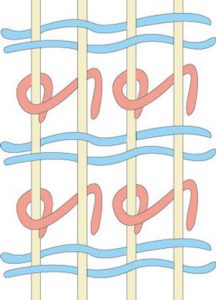
The asymmetrical knot is also known as the Persian knot or the Senneh knot. Sometimes it goes by the name farsibaff. In the asymmetrical knot the yarn (marked with red ) is placed in a loop around one warp thread (light yellow) and remains loose under the other warp thread. Between every row of knots the weft (blue) is placed in one or more rows. The asymmetrical knot makes it possible to weave a carpet with higher knot density and more details. This knot is used in the Persian workshops (Iran) and in India, Turkey, Egypt and in China.
Symmetrical knot
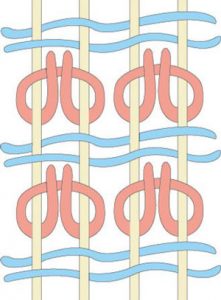
The symmetrical knot, also known as the Turkish knot or the Ghiordes knot from its origin in Turkey where it was originally used. Sometimes this knot also goes by the name of turkbaff. In the symmetrical knot the yarn is placed (marked with red in the illustration ) in a loop around each and one of the two warps (light yellow ). Between every row of knots a weft is placed (coloured with blue ) in one or many rows. The symmetrical knot provides a stronger consistency to the carpet and is often used for thicker carpets. This knot is being used in Turkey, the Caucasian area and in the western parts of Iran and by Turkish and Kurdish tribes. It is also used in some European carpets.
Tibetan knot
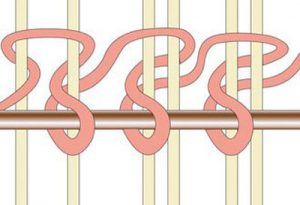
The Tibetan knot has a completely different structure than the other knots. This knot is made by using a temporary rod (brown in the illustration) along the width of the carpet, which is placed in front of the warp (light yellow) .
The long yarn (red) is then placed around two warp threads (light yellow) and then around the rod. When the weaver is done with the entire row of knots the loops around the rod are cut to create the knot.
Jufti knot
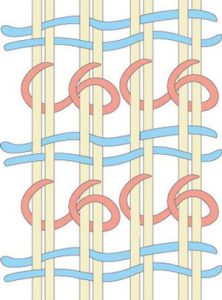
A Jufti knot means that the knot (marked with red) is placed over four, instead of two, warp threads (light yellow) . The weft (blue) is placed in one or more rows.
When weaving a carpet with this knot, the work goes on faster, but at the expense of the knot density. The carpets also tend to be less durable and the surface can sometimes look loose and shaggy. Of course the carpet is cheaper but also much worse. The knot can be both symmetrical and asymmetrical. The Jufti knot can be found in Khorasan carpets from Iran.
knot counting importance
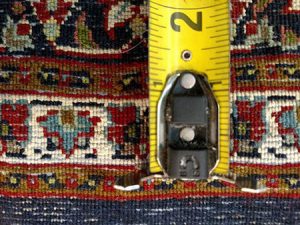
Since the knots in a rug are tied by hand and since a weaver can tie approximately 8000 knots per day, the number of knots per square inch (kpsi) times the number of square inches gives some approximation of the labor content. It can literally take 9-12 months to produce one 9′ x 12′ hand knotted rug! Typically, the pattern and colors are what makes a rug attractive to the beholder! And since the joy of an handmade rug is the pattern, the complexity of the pattern and the execution of the weave, these complexities make it difficult to compare similar knots per square inch from the different countries, villages or nomadic tribes. In addition, each country and tribe has a different method for defining their basis for knot counts. There are also many knot constructions used by each country or tribe.
How to Measure Knot-Count: The Persian Way
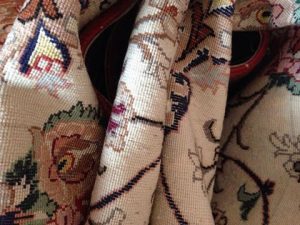
Have you ever wondered how Persians determine the quality of a rug? For centuries, two methods passed down between generations have been used as the definitive methods of measuring the quality of the weave of a rug. By following the steps below you can learn one of the oldest secrets of the Bazaar.
The Traditional Method of Measuring Knot Density
When it comes to measuring the knot count of a rug in Iran, you will hear one of two terms. ‘Kheft’- most commonly used in Esfahan , and ‘Raj’- most commonly used in Tabriz. These two methods differ very slightly but revolve around the same principle of estimating the number of knots within an area of a row of knotting.
Measuring by Kheft
‘Kheft’ is one of the most traditional measurements in Iran. To measure knot density by Kheft, follow these steps:
- Turn over your rug so that the underside faces up towards the ceiling
- Use a ruler to measure 6.5cm across its width
- Count the number of knots within the 6.5cm you measured
You now have the ‘Kheft’ of your rug. You can use this figure as an estimate of its quality using the following scale:
- Very High: 75+
- High: 74-60
- Medium: 59-40
- Low: 39-15
- Very Low: 14 or fewer
Measuring by Raj
To measure by ‘Raj’, follow the same steps as above, but use a sample size of 7cm rather than 6.5cm. As the sample size is slightly different, the scale used to determine quality also is.
- Very High: 85+
- High: 84-70
- Medium: 69-50
- Low: 49-25
- Very Low: 24 or fewer
oriental handmade caropet knotcounting
In the Varanasi area of India, rugs are graded using two numbers, like “5/40,” “9/60,” or “12/60.” The first number represents the knots in 9/10 of an inch of the rug’s width. The second number represents the knots in 4 1/2 inches of the rug’s length. 0.9″ x 4.5″ equals 4.05″, almost four square inches, so an easy conversion is to multiply the two numbers together and divide by 4 (sq. in.) to get the approximate weave in knots per sq. in. For example, with a “9/60” quality rug, 9 X 60=540 and 540/4=135 knots per sq. in. Note that most rugs from India have strongly offset warps, so you will only see one element of the knot on the back of the rug. In Pakistan, indicated qualities like “16/16” or “16/18” for rugs in Persian design represent the number of knots per linear inch across the warp and weft counted in the normal way. For example, a “16/18” quality Kashan has 16 X 18 weave, or about 288 knots per sq. in. Note that these rugs have strongly offset warps, so you will only see one element of the knot on the back of the rug. So-called “double” Bokharas from Pakistan in qualities like “9/18,” “10/20,” “11/22,” and “12/24” are different. In this type of rug, warps lie side-by-side and are not offset, so both elements of the knot show on the back of the rug. Be sure not to double-count the weave across the width when examining a Bokhara. China uses a completely different nomenclature, with “line counts” like “70 line,” “90 line,” or “120 line.” The line count equals the number of knots in a linear foot measured across the width of the rug. Thus a “90 line” rug has 90 knots per linear foot across its width. A “90 line” Chinese rug has about 56 knots per sq. in.; a “SINO-PERSIAN” (a Chinese rug in Persian design) in “160 line” quality has about 177 knots per sq. in.; a “240 line” rug has about 400 knots per sq. in. Chinese rugs have strongly offset warps, so you will only see one element of the knot on the back of the rug.







